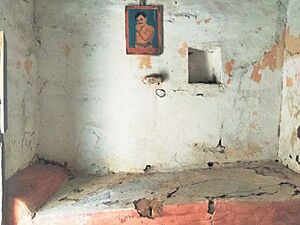Chandra Shekhar Azad facts for kids
Quick facts for kids
Chandra Shekhar Azad
|
|
|---|---|

Azad in 1926
|
|
| Born |
Chandra Shekhar Sitaram Tiwari
23 July 1906 Bhabhra, Alirajpur State, British India
|
| Died | 27 February 1931 (aged 24) Allahabad, United Provinces, British India
|
| Other names |
|
| Occupation | Revolutionary |
| Organization | Hindustan Socialist Republican Association |
| Movement | Indian Independence Movement |
Chandra Shekhar Azad (born Chandra Shekhar Sitaram Tiwari; 23 July 1906 – 27 February 1931) was a brave Indian freedom fighter. He was a key leader in the fight for India's freedom from British rule. After the first leader, Ram Prasad Bismil, passed away, Azad took charge and reorganized the Hindustan Republican Association (HRA). He renamed it the Hindustan Socialist Republican Association (HSRA). He used the name "Azad," which means "The Free," to show his spirit.
Contents
Early Life and His Name
Chandra Shekhar Azad was born on 23 July 1906 in a village called Bhabhra. His family was from a village named Badarka in Uttar Pradesh. His mother, Jagrani Devi, wanted him to become a great Sanskrit scholar. So, she sent him to study in Banaras.
In 1921, when he was just 15 years old, a big movement called the Non-Cooperation Movement was happening. This movement, led by Mahatma Gandhi, aimed to protest British rule peacefully. Chandra Shekhar joined in. He was arrested on 20 December. When he was brought before a judge, he famously said his name was "Azad" (meaning "The Free"). He said his father's name was "Swatantrata" (meaning "Independence") and his home was "Jail." The judge was angry and ordered him to be whipped 15 times.
Becoming a Revolutionary
After the Non-Cooperation Movement was stopped in 1922, Azad felt very disappointed. He then met a young revolutionary named Manmath Nath Gupta. Gupta introduced him to Ram Prasad Bismil, who had started the Hindustan Republican Association (HRA). This group wanted to achieve India's freedom through revolutionary actions.
Azad quickly became an active member of the HRA. He helped raise money for the group, often by taking funds from government property. He was involved in important events like the Kakori Train Robbery in 1925. He also took part in the shooting of John P. Saunders in Lahore in 1928. This was done to get revenge for the death of Lala Lajpat Rai, a respected leader.
Azad also studied ideas about a better society. He learned about socialism from books like "The Communist Manifesto." He wanted to teach these ideas to others in his group.
Activities in Jhansi
Azad made the city of Jhansi a main base for his group for some time. He used a forest near Orchha, about 15 kilometers from Jhansi, for shooting practice. He was a very good shot and trained other members of his team.
He even built a small hut near a temple by the Satar River. He lived there for a long time, pretending to be a priest named Pandit Harishankar Bramhachari. He taught children from a nearby village. This helped him connect well with the local people. While in Jhansi, he also learned how to drive a car. Many other revolutionaries joined him there.
Working with Bhagat Singh
The Hindustan Republican Association (HRA) was first formed in 1923. After the Kakori train robbery in 1925, the British government cracked down on the revolutionaries. Many leaders were caught and sentenced to death. Azad managed to escape capture.
In 1928, Azad worked with Bhagat Singh and other revolutionaries to reorganize the HRA. They renamed it the Hindustan Socialist Republican Association (HSRA). Their main goal was to achieve a free and socialist India.
Azad then planned with Shivaram Rajguru, Sukhdev Thapar, and Bhagat Singh to get revenge for Lala Lajpat Rai's death. They aimed to target a police officer named James A. Scott. However, by mistake, they shot John P. Saunders, another police officer, in Lahore on 17 December 1928. Azad also shot an Indian police officer who was chasing them.
His Final Fight
On 27 February 1931, the police in Allahabad received a tip that Azad was in Alfred Park. He was meeting with his friend and fellow revolutionary, Sukhdev Raj. The police quickly surrounded the park.
A shootout began. Azad fought bravely, killing three policemen. He was badly wounded but continued to fight to help his friend Sukhdev Raj escape. Azad told him to leave so he could continue the fight for freedom. He gave cover fire while Raj got away safely.
Azad hid behind a tree and kept firing at the police. The police fired back. After a long fight, he died. He had vowed never to be captured alive by the British.
His body was taken away for cremation without telling the public. But when people found out, they gathered at the park. They shouted slogans against the British government and praised Azad for his sacrifice.
Remembering Azad
Chandra Shekhar Azad is remembered as a fearless leader who gave his life for India's freedom. Many schools, colleges, and roads across India are named after him.
His story has been told in many films and TV shows. Actors like Aamir Khan and Sunny Deol have played him on screen. These stories help new generations understand the sacrifices made by revolutionaries like Azad for India's independence. His courage and dedication continue to inspire people today.
See also
- Bhagat Singh
- Ashfaqulla Khan
- Kakori Train Robbery
- History of India
- Partition of India
- Partition of Bengal (1905)
- Independence Day (India)
- Indian independence movement
- Revolutionary movement for Indian independence
- Women of the Indian independence movement





